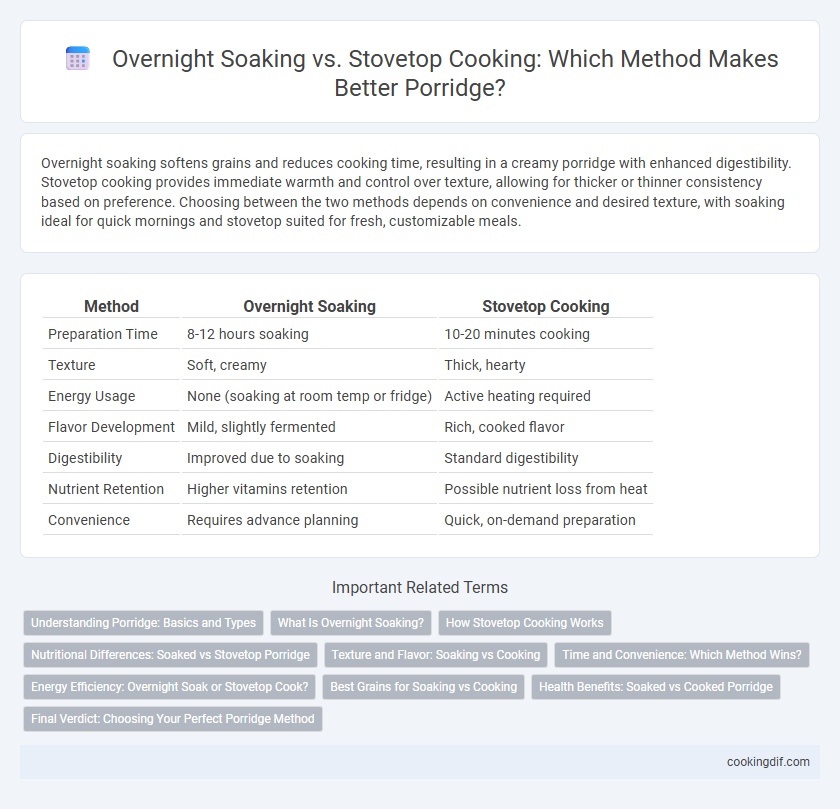Overnight soaking softens grains and reduces cooking time, resulting in a creamy porridge with enhanced digestibility. Stovetop cooking provides immediate warmth and control over texture, allowing for thicker or thinner consistency based on preference. Choosing between the two methods depends on convenience and desired texture, with soaking ideal for quick mornings and stovetop suited for fresh, customizable meals.
Table of Comparison
| Method | Overnight Soaking | Stovetop Cooking |
|---|---|---|
| Preparation Time | 8-12 hours soaking | 10-20 minutes cooking |
| Texture | Soft, creamy | Thick, hearty |
| Energy Usage | None (soaking at room temp or fridge) | Active heating required |
| Flavor Development | Mild, slightly fermented | Rich, cooked flavor |
| Digestibility | Improved due to soaking | Standard digestibility |
| Nutrient Retention | Higher vitamins retention | Possible nutrient loss from heat |
| Convenience | Requires advance planning | Quick, on-demand preparation |
Understanding Porridge: Basics and Types
Overnight soaking softens grains like oats or millet, enhancing digestibility and reducing cooking time while preserving nutrients. Stovetop cooking involves boiling grains, offering a quicker texture adjustment and caramelization for richer flavor. Both methods cater to various porridge types, from creamy oat porridge to hearty rice or cornmeal porridges, affecting texture and nutritional profile.
What Is Overnight Soaking?
Overnight soaking involves submerging oats in liquid, such as milk or water, for several hours or overnight, allowing the grains to absorb moisture and soften without heat. This method enhances digestibility and boosts nutrient availability while saving morning preparation time. Compared to stovetop cooking, overnight soaking yields a creamier texture and preserves heat-sensitive vitamins.
How Stovetop Cooking Works
Stovetop cooking for porridge involves simmering grains in water or milk over medium heat, allowing heat to evenly penetrate and soften the grains for a creamy texture. This method activates starches quickly, producing a thicker consistency compared to overnight soaking, which relies on prolonged hydration without heat. Adjusting cooking time and liquid ratios directly influences the porridge's density and flavor development during stovetop preparation.
Nutritional Differences: Soaked vs Stovetop Porridge
Overnight soaking of porridge grains increases nutrient bioavailability by initiating enzymatic activity that breaks down phytic acid, enhancing mineral absorption such as iron and zinc. Stovetop cooking tends to reduce heat-sensitive vitamins like B-complex and vitamin C due to prolonged exposure to high temperatures. Soaked porridge retains more antioxidants and certain B vitamins compared to stovetop methods, making it nutritionally superior for mineral uptake and enzymatic benefits.
Texture and Flavor: Soaking vs Cooking
Overnight soaking for porridge softens grains evenly, resulting in a creamier texture and enhanced natural sweetness due to gradual water absorption. Stovetop cooking applies direct heat, producing a thicker, more robust porridge with a slightly toasted flavor from caramelization. Texture differences are notable, as soaked porridge tends to be smoother while stovetop cooking creates heartier, chewier grains.
Time and Convenience: Which Method Wins?
Overnight soaking porridge requires minimal active preparation, allowing grains to absorb liquid and soften naturally, saving valuable morning time and enhancing digestion. Stovetop cooking demands continuous monitoring and stirring, typically taking 10-20 minutes, which may be less convenient for busy schedules. For ultimate time efficiency, overnight soaking wins by offering effortless readiness without compromising texture or flavor.
Energy Efficiency: Overnight Soak or Stovetop Cook?
Overnight soaking porridge significantly reduces energy consumption by allowing grains to soften naturally without heat, minimizing stovetop cooking time and fuel use. Stovetop cooking demands continuous heat, consuming more energy compared to soaking methods. Choosing overnight soaking enhances energy efficiency while maintaining porridge's nutritional value and texture.
Best Grains for Soaking vs Cooking
Whole oats and steel-cut oats are ideal for overnight soaking since their firm texture softens and enhances digestibility without losing nutrients. Rolled oats and quick oats perform better with stovetop cooking, as their thinner, flattened structure cooks rapidly, delivering a creamy porridge consistency. Ancient grains like quinoa and millet benefit from soaking to reduce cooking time and improve nutrient absorption, while grains such as barley are best prepared through stovetop simmering to fully develop their hearty flavors.
Health Benefits: Soaked vs Cooked Porridge
Overnight soaking of porridge grains enhances nutrient absorption by reducing phytic acid, which improves mineral bioavailability, particularly iron and zinc. Stovetop cooking breaks down starches, making porridge easier to digest while preserving heat-sensitive vitamins like B-complex and folate. Soaked porridge supports gut health through natural fermentation, promoting beneficial gut bacteria and reducing anti-nutrients compared to traditionally cooked porridge.
Final Verdict: Choosing Your Perfect Porridge Method
Overnight soaking preserves more nutrients and saves morning prep time, delivering a creamier texture with minimal effort. Stovetop cooking allows precise control over consistency and flavor development, ideal for those who enjoy a freshly cooked, customizable porridge. Choosing between overnight soaking and stovetop cooking depends on your lifestyle preferences, desired texture, and time constraints for the perfect porridge experience.
Overnight soaking vs stovetop cooking for porridge Infographic

 cookingdif.com
cookingdif.com